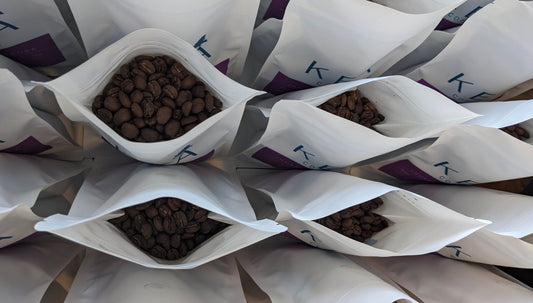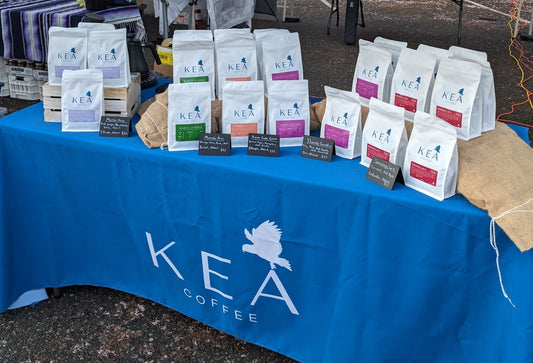Bright, vibrant acidity, fruity sweetness and rich caramels ...
A great Bourbon (done properly!) is always a treat.
Today we're going to take a deep dive and chat all about one of our favourite varietals.
Let's dig in ...
Jump to
Where Is Bourbon Commonly Grown?
What Are Some Common Bourbon Taste Notes?
Washed Vs Natural - Effects On Cup Profiles
Red Bourbon Vs Yellow Bourbon Vs Pink Bourbon
Can You Brew Bourbon As Espresso?
What Is Bourbon Coffee?
Bourbon is a varietal that's thought to have originated on Réunion Island - a small island off the East coast of southern Africa.
There are a few different sub species of Bourbon. Red Bourbon and Yellow Bourbon being the 2 most common.
Confusingly, there's also Pink Bourbon, although Pink Bourbon is now known to not be Bourbon at all, but is actually it's own varietal and not genetically related to Bourbon at all. But more on that another day...
There are also many other varietals that have evolved from Bourbon, such as Pacas, Caturra, and SL34 to name just a few of the most popular and well known ones.
In general, Bourbon typically has very high cup quality, and is usually very highly regarded in specialty coffee.
Look for high elevation Bourbon's in particular, as this varietal does exceptionally well at altitude.
What you need to know about Bourbon
- It's a natural mutation of the Typica varietal
- It has a lower yield than many other varietals
- Bourbon plants are tall with small cherries that ripen to either red or yellow
- Similar to Geisha, Bourbon excels in quality when grown at higher altitudes, and does considerably less well at lower altitude
- It's very susceptible to pests and diseases (coffee leaf rust in particular)
- Bourbon is renowned for a consistent, excellent quality cup
Where is Bourbon Coffee Usually Grown?
There are a few different types of Bourbon, and some of them are more popular in certain regions than others - we'll get more into that a little later.
Since Bourbon is such a high quality and sought after varietal in terms of cup quality, it's common to see different sub species of it grown in many coffee growing countries and regions around the world.
Although it has its roots in Africa, it is also widely grown in certain parts of Latin America too.
In the early days of coffee production in Brazil, for example, Bourbon played a crucial role. It's less common there today than it was, since most of the country lacks the elevation to do the varietal real justice, but other central and south American countries such as Colombia, Guatemala, Honduras, Peru and Costa Rica still produce exceptional Bourbon lots every year.
Back in Africa, Bourbon is very common in Rwanda where it accounts for the majority of the countries harvest. It can also be found growing in neighbouring Burundi and Tanzania.
What does Bourbon coffee taste like?
Common qualities you'll see associated with Bourbon include things like:
- "bright acidity"
- "complexity"
- "high sweetness"
The flavour profiles can also very slightly based on origin. Some general and high level themes you might find are as follows...
- El Salvador Bourbon (most commonly Pink Bourbon): Buttery, toffee flavors. You'll also find plenty of Red and Yellow Bourbon across El Salvador, as well as the less common Orange Bourbon.
- Rwanda Bourbon: Different variations and mutations of Bourbon have grown wild here for centuries, and it is still one of the countries primary varietals. Rwandan Bourbon tends to have a fruitier punch, with that classic Bourbon style vibrant acidity going on.
- Brazil Bourbon: Brazilian Yellow Bourbon is often described as having a honey like sweetness. You'll usually find lots of fruity notes and a balanced mix of sweetness and acidity. Other Brazilian Bourbons can lean more into those classic Brazil flavours of nuts and caramels.
- Colombia Bourbon (Pink Bourbon is more common here): Often quite floral, with a citrus and almost effervescent acidity.
- Guetemala. High altitude regions such as HueHue and Antigua host some great Bourbons. In classic Guatemalan style, these Bourbons tend to lead with chocolatey or caramel notes, but with some complex and subtle nuances - expect to see plenty of soft fruits and floral notes and occasional stone fruit.
- Kenya. Not usually a country closely associated with Bourbon, but did you know that Kenyas famous SL28 and SL34 varietals are actually selections from Bourbon?! Kenyan coffees are usually complex and high in acidity - qualities that the SL28's and SL34's likely inherit from Bourbon.
Washed Vs Natural Bourbons
As with any varietal, the post harvest processing method plays a big role in determining the end cup profile.
In general, natural processed Bourbons tend to lean into their balanced, fruitier nature, while washed processed Bourbon lots can skew more toward showcasing that crisp and vibrant acidity that the varietal is known for.
Bourbon Sub Species - Red Vs Yellow Vs Pink
Red Bourbon
Red Bourbon coffee cherries when ripe are a deep red colour (surprise surprise!) and are generally a bit more balanced and rounded in the cup.
You'll get plenty of sweet, fruity notes of berries and various red fruits, coupled with a fuller body and often some deeper notes of chocolate and caramel.
Sometimes, Red Bourbon can throw up some really subtle spice notes on the finish too.
It's widely cultivated in most of the places you'd probably expect - Rwanda in Africa, and Colombia, El Salvador and Brazil in Central and South America.
Yellow Bourbon
Yellow Bourbon will often present with a more subtle but sharper acidity - think citrus notes such as lemon.
It's a natural mutation from Red Bourbon, which was found in Brazil in the 1930s and is still commonly grown there today.
Actually, most Yellow Bourbon production still happens in Brazil, although it can also be found growing in Colombia and some other South and Central American countries now.
Since Yellow Bourbon is most commonly grown in Brazil, you can usually expect to see more fruity and balanced flavours, with chocolate or caramel notes and a full creamy body.
Pink Bourbon
Pink Bourbon feels like it's rocketed into the spotlight over the last few years.
It's a varietal that's picked up a lot of traction (and rightly so!), and has been an increasing focus on the competition circuit too.
For a long time, Pink Bourbon was thought to have it's origins in the Bourbon family. We believed it to be a natural cross between Red Bourbon and Yellow Bourbon.
But recent research by Cafe Imports has now confirmed that Pink Bourbon is not actually a Bourbon at all. It's actually an Ethiopian Landrace.
In hindsight, this probably should have been obvious to us all from the beginning.
Pink Bourbon cups quite differently to Red and Yellow, often with a more effervescent style acidity that's still really crisp and vibrant.
Where Pink Bourbon really differs though, is the dialed up complexity. You'll often find lots of floral notes and various sweet tropical fruits like mango, passionfruit and papaya. Expect lots of big, juicy sweetness.
How To Brew Bourbon - Tips
Since Bourbon is usually such a high quality and highly regarded coffee, you'll most commonly see it as a single origin, lighter roast.
Because of that, all of our light roast coffee brewing tips apply.
Outside of that, we've had great success with some Bourbons by grinding a little finer than usual, and tightening up the ratio. If you check out the brew guides for our recent Rwandan Bourbon from Nova Washing Station, for example, you'll notice we're brewing closer to a 1:15 Vs our usual starting point of 1:16. But we're also coupling that with a grind size that's slightly finer.
As we mentioned above, many Bourbon lots can tend to have a really high acidity.
If you want to balance that out a little bit, grinding a pinch finer can really help to bring out a bit more sweetness. You might also prefer to switch to a flat bottom brewer over a conical one.
Can Bourbon Coffee Work Well On Espresso?
As with any varietal, whether it works well on espresso or not depends on 2 things:
- How it was roasted.
- How you define espresso, and what you're looking to get out.
Let's chat about #1 quickly first, as that's the simplest one.
There's pretty much 2 different styles or roaster.
Some roasters will develop 2 different roast profiles for the same coffee. They will have 1 roast profile (think, recipe) that's designed to work well with filter brewing, and a 2nd profile that's designed to work better with espresso brewing.
Generally speaking, espresso profiles tend to be a little bit longer in time, and filter profiles are shorter.
The slightly longer roast time will help develop a little bit more sweetness and dial down the acidity, so it's not too overpowering in an espresso.
You can absolutely still take a filter roast and brew it up on espresso. It'll just be a bit punchier and more intense, particularly on the acidity side of things, than you might expect or potentially want.
The 2nd style of roasting, which is what we do here at Kea, is called omniroasts.
With an omniroast, the roaster develops profiles that are designed to work well on both filter and espresso equally.
We love roasting in this style because it means that someone who buys a bag of our beans can experiment and brew tasty filter and espresso versions of the same exact coffee, without needing to buy 2 different bags.
So when you're looking for a Bourbon to use on espresso, just keep in mind that you'll probably want to look for either a specific espresso roast, or find a good roaster who focuses on omniroasts. Shameless plug: here's our current single origin coffee line up if you're interested in the omniroast option.
Alright, now the 2nd bit.
This is where it gets a bit more complicated, and we will most likely dedicate a future blog to exploring this in much more detail.
As we mentioned above, since Bourbon is often very highly regarded, you'll most commonly find it expressed as a lighter roast, as that tends to help highlight and bring out all of the things that make Bourbon great.
With that said, there's a good chance that a Bourbon espresso is going to be a relatively light roast espresso.
Dialing in and brewing light roast espresso is a huge other topic, and one that we'll dig into more deeply in a future blog, but here are a few great resources to check out in the mean time:
- Lance Hedrick: How To Dial In Light Roast Espresso
- This reddit thread has some good tips
- Try out a turbo shot
Sooo... with all of that in mind... can Bourbon work well on espresso?
Absolutely!
We love Bourbon on espresso.
But just remember that you'll most likely end up with a different, more modern style of espresso, since you'll most likely be working with a lighter roast.
Our top tip for finding a great Bourbon for espresso would be to look for natural processed lots in particular. These tend to be sweeter and fruitier, whilst still retaining a good amount of that classic Bourbon acidity and vibrancy.
The fruiter notes highlighted by the natural process will help create a bit more balance in your espresso shot, and stop the acidity from being overpowering and taking over the cup.





